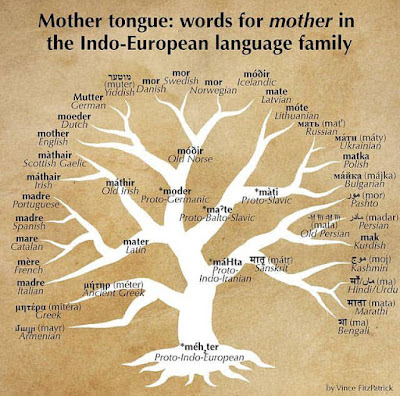Language Trees: The Importance of Mother
I recently saw this image appear in my feed on Facebook, and although I think it is better than a lot of illustrations of language trees that I have seen, it makes no sense that a primarily English illustration of a language tree fails to include Old English. For those of you wondering, the OE word for mother is “modor.” As such, on this diagram it should be the branch off of Proto-Germanic which is not the branch labeled Old Norse. (I will relabel the diagram below so you can see what I mean.)
There are a lot of perfectly terrible language trees out there, so by comparison this one is fairly good. The actual form of a tree really lends itself to illustrating the evolution of language as it splits into branches of varying lengths. I spend a lot of time looking at different languages for fun in my spare time. My current focus is Norwegian, but I have a background in Old English from my university years and I have studied Old Norse and Icelandic on my own. One thing that bothers me with a lot of the language tree diagrams is that they make Modern English and Old Norse seem so far away. Take a look at the below example.
It really shows you how important a good image is. The reality is that Old Norse heavily affected the formation of Modern English. Old English and Old Norse were really not that far off from each other to start. Some would even argue that the two languages are mutually intelligible. I noticed this when I first tried to pick up Old Norse, already having a background in Old English. A lot of it was so similar it felt instinctual when I was reading the texts.
Old Norse further influenced Modern English due to the numerous migrations and inhabitations of the Norse people in what is now England and Scotland. Words that came with these migrants stuck around in many cases. Similarly, Old English had an impact on Old Norse as well, which is why languages like Norwegian are easier for English speakers to learn. The words and syntax are quite similar.
I love language and could nerd out all day, but back to the topic of the first diagram. The word is mother, and you can see it is one word that is almost universally understood in its similarities across languages and cultures. Its Proto-Indo European roots as méhter have survived remarkably well, because the importance of the concept of mother is inherent. Written sources may try to obscure the vital roles women played in societies of the past, but in a single word, passed down in oral traditions for centuries, the truth is revealed.
Further Reading and Viewing:
"A Conversation in Old English and Old Norse"
https://www.youtube.com/watch?v=eTqI6P6iwbE
“Could the Vikings Understand the Anglo-Saxons? Old Norse & Old English Mutual Intelligibility?”
https://www.youtube.com/watch?v=gTCw3H5Y0pc
"Defining the Outcome of Language Contact: Old English and Old Norse" by Hope C. Dawson
"English Keywords in Old Norse Literature" by Hans-Peter Naumann
“English words of Norse origin”
http://fig.cox.miami.edu/~burgess/norse/words.html
"Norsified English or Anglicized Norse?" by Peter Trudgill
“Old Norse and Old English”
https://www.youtube.com/watch?v=BaWgJq9OVGM
“Old English Mutual Intelligibility”
https://forum.unilang.org/viewtopic.php?t=14400
"The Level of Old Norse Influence on the Development of Middle English" by Hanna Dorthea Hellem
Photo Sources:
“Mother Tongue” by Vince FitzPatrick
"The Indo-European Family of Languages" by Unknown (2010)




